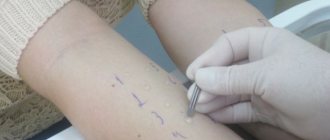The need to do allergy tests has become very common over the past 10 - 20 years. All case studies on the epidemiology of allergic diseases indicate an unprecedented (tenfold) increase in the incidence of allergic diseases among both children and adults.
In addition to the simple increase in the number of people suffering from allergies, there is a phenomenon called the “allergic march”, which consists in accelerating the progression of various manifestations of allergies in a child compared, for example, with his parents or grandparents.
It has long been no secret that allergies are inherited. In clinical practice, one often encounters the following picture: a baby is brought in for an appointment, 3–5 months old, and he already has not only red, “flaming” cheeks, but also on many other parts of the body (usually on the neck, chest , thighs and legs) there are extensive areas of coarsening (lichenification), peeling, and cracks through which lymphatic fluid can protrude, which then dries out and turns into thick crusts. You start asking your parents, that is, scientifically speaking, collecting anamnesis: who had allergies in childhood? In 90% of cases, both parents will unanimously say that no, no, no one has ever had this. And only after much torment under the influence of an artificial light source directed into the eyes do they begin to remember that: either mom suffered from cold urticaria in childhood, or dad had a red bottom before the age of one year, but then everything went away, and they forgot.
But neither their own fathers and mothers, that is, the child’s grandparents, can no longer remember such disgrace as we see in their own child.
This is what, figuratively speaking, the allergic march is an acceleration of the progression of allergy symptoms and an increase in the degree of their severity in modern children who have a hereditary (genetic) predisposition.
Types of allergy tests
They are divided into two types: this is a test for a suspected allergen, skin reaction and blood reaction. The advantages of the first type are that skin tests are reliable, simple and cheaper, and the patient receives the result immediately. Blood tests take longer and are more expensive, but they do not cause allergic reactions.
Skin testing
Although skin tests are performed in different ways, the principle is the same - a small amount of allergen(s) is applied to the skin, and then the site of application is carefully examined. The observation time for the reaction is limited to 15 minutes, the results of skin tests become known immediately after they are carried out.
Skin allergy tests
Skin testing can be done on anyone (child or adult). This method has virtually no contraindications.
Allergens that are applied to the skin during research, if carried out correctly, are not dangerous. At our clinic, allergists are trained to provide emergency care.
In addition to scratch and prick tests, there is an intradermal (intradermal) allergy test. It is carried out by injecting a small amount of the allergen directly into the skin. This method is used when the results of skin tests have an ambiguous interpretation.
Another test is to use a special patch on which the allergen is applied. This method is often used to identify contact dermatitis. A patch with an applied allergen is attached to an area of the patient’s skin, and after 24-72 hours the reaction to it is analyzed.
Skin tests have the following set of allergens:
- standard formulations of drugs required for specific immunotherapy;
- food and inhalation allergens;
- occupational allergens;
- mixture of allergens.
Allergy tests by blood
As a result of interaction with allergens, specific IgE antibodies are formed in an allergic patient. By assessing the amount of antibodies, you can identify the allergen and the severity of the allergic reaction.
To determine allergens by blood, it is necessary to draw blood and have it tested in the laboratory. The results will be known in 3-5 days. Unlike skin tests, blood tests take longer. The result is expressed quantitatively and allows you to track indicators throughout the entire treatment period. The peculiarity of in vitro diagnostics is that it is carried out using kits that determine total and specific IgE, which are based on the classical ELISA and RIA technologies.
The choice of diagnostic method is up to the doctor. Sometimes a combination of these options is used. The test result cannot be treated. It is necessary to treat the patient with complaints, manifestations of the disease, his concomitant diseases and the results of allergy studies. Therefore, the role of an allergist in making a diagnosis remains irreplaceable and main.
Diagnostic allergy tests
Will allergy tests help in diagnosing allergies in an infant?
Answer: they can help, but not much. Of course, in a number of severe cases, when a pregnant mother leaned heavily on, say, chocolate throughout her pregnancy, drank milk in liters or ate a mixture of walnuts and honey, then in this case the child may develop a hidden, latent allergy to cow protein in utero milk, nuts, fish or chocolate, in which case allergy tests will certainly give us results. In most cases, in the first six months of life, the level of specific immunoglobulins E in a child is still so low, and these antibodies do not stay in the blood for long, since their main target is mast cell receptors, so the result of allergy tests taken from a baby in the first months of life is in most cases, except for those I mentioned earlier, it will be negative.
Somewhere closer to a year, of course, you can confidently refer the child for allergy tests, but before that it is better to ask the mother to keep a food diary for a month or two in order to then compare the results of the allergy tests with the observations of the mother herself.
Frequently asked questions from patients about allergy tests
Do I need to take a blood test for allergies and why?
First of all, we must summarize that allergy tests help identify allergic reactions in the body and the specific allergen that causes them.
Blood samples for allergy testing are taken in the following cases:
- The patient has skin conditions that prevent skin testing. For example, he has hives, lichen, eczema, etc.;
- The patient is taking antidepressants or antihistamines and cannot stop taking them. However, against their background, the allergic reaction will be reduced, and the result will become false;
- A strong reaction to the allergen, so-called anaphylaxis, may occur;
- The patient's skin tests were positive for several allergens.
Epicutaneous test (plasters)
Skin patch samples help detect slow-type allergic reactions when allergic contact dermatitis is suspected.
Special hypoallergenic patches with hypoallergenic metal capsules containing natural food allergens are applied to the intact skin of the back for 48 hours.
Epicutaneous test (plasters)
The reaction is assessed twice: 48 hours after removing the patch, and after another 72 hours. The results obtained after the first and second assessments are then compared.
Why are allergy tests dangerous?
Skin testing for allergies is not completely safe, as it may be accompanied by anaphylaxis, which is the body's severe allergic reaction to an allergen. Among the symptoms of this complication, the main ones are: low blood pressure, itching, breathing problems and swelling of the face or the whole body.
Anaphylaxis seriously affects the patient’s health, but it occurs extremely rarely, and in skin tests in general in isolated cases.
When donating blood for such an analysis, you don’t have to worry about any risks other than those associated with the blood collection itself - these are bruises and phlebitis, i.e. phlebitis. To alleviate your condition, it is recommended to apply warm compresses 2-3 times a day. But when taking blood thinners, you should be prepared for bleeding during collection.
Examples of provocation
When, after various studies, having learned about the food consumed, specialists discover a suspicious allergen, an elimination diet is prescribed, i.e. the allergenic product is removed from the menu. This diet usually lasts about 2 weeks.
Then a provocation is given, including a product temporarily excluded from the diet. If characteristic allergy symptoms appear, then we can indeed say that the allergen is to blame.
Provocative samples with suspected allergens and provocative inhalation samples of the mucous membrane (nasal, conjunctival, sublingual) can also be performed.
Cost of skin tests
| Skin tests | ✕| |
| Carrying out a skin allergy test using the scarification method | 1500 |
| Carrying out a skin allergy test using the prick test method | 2000 |
Skin prick tests with 6 household allergens:
| 1500 |
Skin prick tests with 4 epidermal allergens:
| 1000 |
Skin prick tests with 6 tree pollen allergens:
| 1500 |
Skin prick tests with 8 meadow grass allergens:
| 2000 |
Skin prick tests with 5 weed allergens:
| 1250 |
Skin prick tests with 6 household allergens:
| 900 |
Skin prick tests with 4 epidermal allergens:
| 600 |
Skin prick tests with 6 tree pollen allergens:
| 900 |
Skin prick tests with 8 meadow grass allergens:
| 1200 |
Skin prick tests with 5 weed allergens:
| 750 |
Allergological scratch tests and prick tests are carried out by an allergist-immunologist after an initial consultation.
During one procedure, the treatment is performed with no more than 15 allergens.
Individual allergens and their classification
Allergens are usually called things that cause an excessive reaction in our body. The list of allergens is very diverse, but it can still be classified into two main groups - exogenous and endogenous.
Exogenous are those allergens that enter the body from the external environment. They can be infectious (fungi, viruses, bacteria, waste products of microorganisms) and non-infectious (house dust, pollen, animal hair, food, certain medications, various chemical compounds).
Endogenous allergens (another name for them are autoallergens) include those that are produced directly by the human body.
Another classification involves dividing allergens into the following types:
- Biological.
Such individual allergens are essentially products of decay or metabolism of biological organisms - bacteria, viruses, helminths, insect poisons, fungi. Allergies can also be caused by vaccines that contain live or weakened microorganisms.
- Food.
Currently, chemical additives are widely added to food products, because of this, the group of food allergens is becoming more diverse and extensive. Foods that most often cause allergies include strawberries, citrus fruits, cow's milk, chocolate, nuts, wheat flour, eggs, seafood and fish. A person suffering from one type of allergy becomes more sensitive to other allergens and has a high risk of developing so-called cross-allergy.
- Industrial.
This type includes allergens that are produced industrially - household chemicals, dyes, reagents, mineral oils, various metals, fertilizers, insect killers. Laundry detergent, perfume, dye or hairspray are highly likely to cause allergies.
- Pollenaceae.
The name of this type of plant allergens speaks for itself. Often allergies are caused by pollen from weeds (ragweed, wormwood, quinoa, nettle), as well as trees during the flowering period (such as birch, hazel, alder, pine, willow, spruce).
- Household.
The most common household individual allergen that can attack a person all year round is house dust, which contains various fungi, waste products and remains of dust mites, hair, dandruff, pet fur, etc.
- Medicinal.
Allergic reactions are often caused by medications. About 18–20% of such cases are associated with the use of novocaine, as well as antibiotics (the most allergic are penicillins of the 1st and 2nd generation). In 7–9% of cases, allergies occur after consuming sulfonamides, vitamins (especially group B), and aspirin.
It is worth considering that, in addition to the allergens themselves, there are also provoking factors, which are illustrated in the figure:
The mechanisms of development of allergic reactions can be classified into the following types:
Type 1 - anaphylactic, immediate, reagin - is associated with the fact that reagin antibodies are formed in the body, which are associated with the presence of IgE . Reactions of this type, which are characteristic, for example, of non-infectious atopic allergies, are most common among children. On the surface of the cells, the allergen and reagin react, causing the release of biologically active substances - the slow-acting substance of anaphylaxis, histamine, etc. The nature of the allergic disease is determined precisely by how these substances affect tissues and organs.
Type 2 – cytotoxic, cytolytic – is observed in immune forms of blood diseases. Reactions of this type take place with the participation of IgE and IgM , as well as cell membranes. The cause of cell destruction is the interaction of antibodies and allergens.
Type 3 - immunocomplex, semi-delayed - is associated primarily with the formation of precipitating antibodies, which belong to the IgG class (IgG4) . Such reactions lead to the formation of immune complexes that cause damage to blood vessels.
Type 4 – cellular, delayed – is most often observed in infectious allergies. During the reactions, sensitized lymphocytes are formed, which, like antibodies, selectively damage tissue.
IgE is a dependent reaction that forms within minutes of contact with an allergen. IgG (IgG4) is a dependent reaction that manifests itself several hours, and sometimes even days after contact with an allergen, and is most characteristic of food allergies.
Recommended articles on the topic:
- Thermal detoxification: lightness of the body and clear skin
- Lipolytic therapy: indications, contraindications, stages of the procedure
- Weight correction: everything you need to know about the procedure
Where can I get allergy tests?
Make an appointment with an allergist-immunologist at the Central Clinical Hospital of the Russian Academy of Sciences in Moscow, where you can submit biomaterial and get a transcript of the results within one day. We welcome patients who suffer from allergies or simply want to make sure they do not react to certain medications, such as antibiotics or anesthesia, before surgery. We perform allergy tests quickly, accurately, and at an affordable price. An appointment with an allergist can be made by phone or online. How much it costs to take the type of allergy test you need is indicated in the clinic’s price list.








